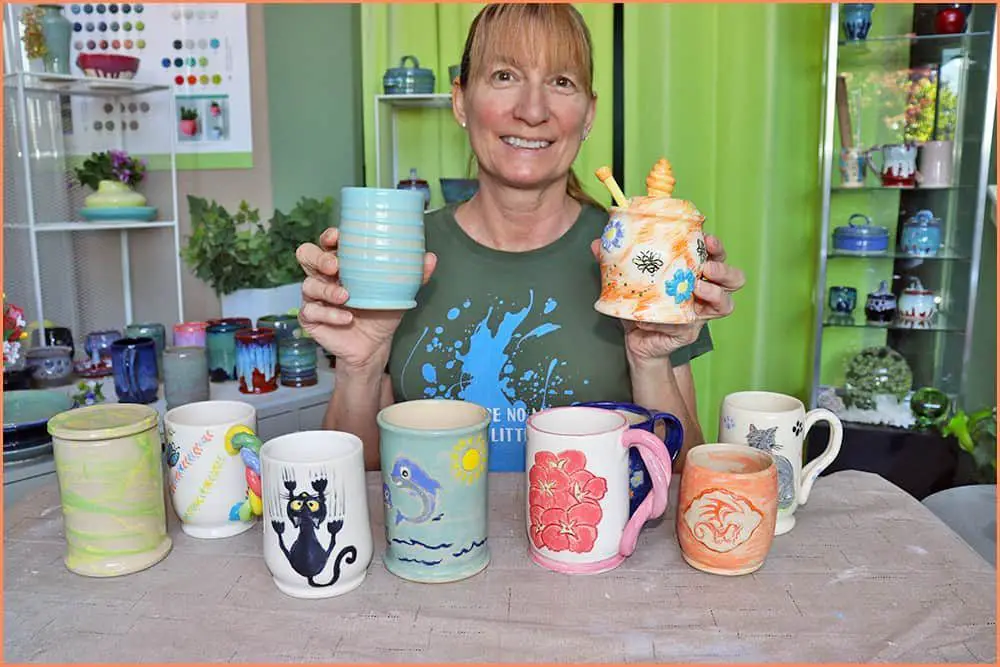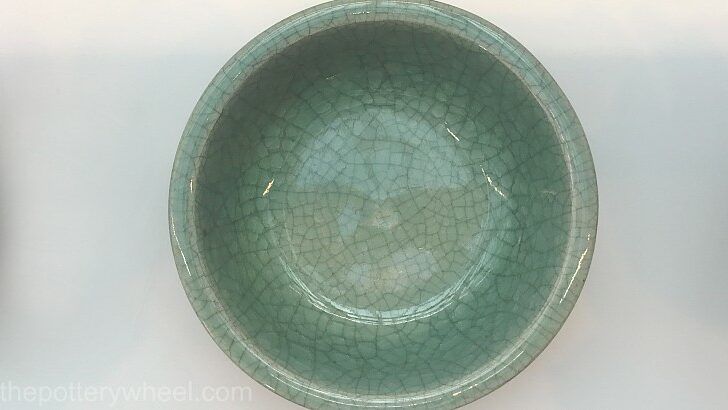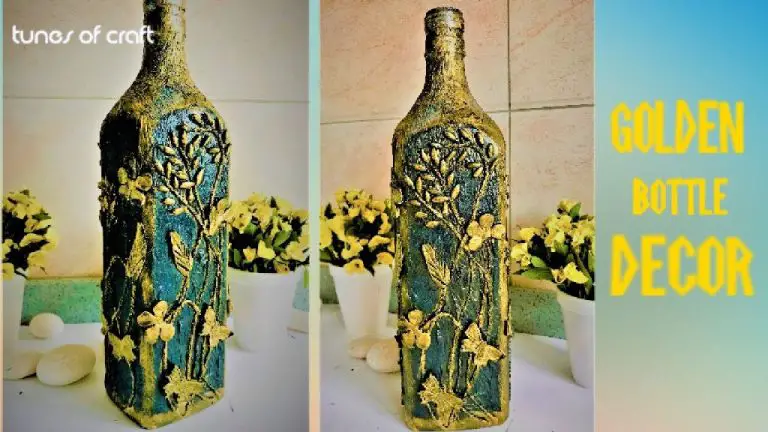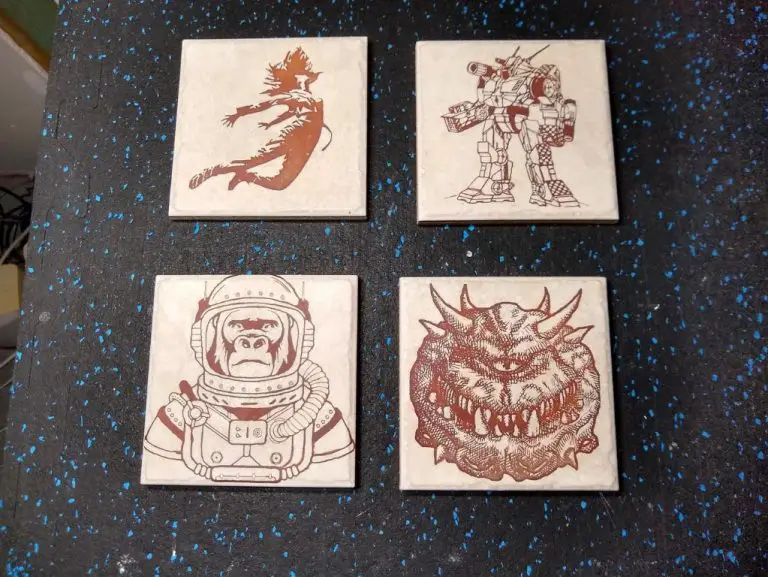What Are Underglaze Pencils Used For?
What Are Underglaze Pencils?
Underglaze pencils are coloring tools used to decorate ceramic surfaces before firing. They are made from ceramic stains mixed with a clay body to form a solid, pencil-like material. Underglazes allow artists to draw fine details directly onto clay in a variety of vivid colors that become permanent after firing.
Underglaze pencils differ from regular drawing pencils in that they are formulated to bond with the silicates in clay when fired at high temperatures. Typical graphite or color pencils burn away in the kiln. Underglaze pencils are made from ceramic materials that fuse into the clay surface during firing.
Underglazes are distinct from glazes in a few key ways. Glazes are glassy coatings applied to the entire surface of pottery that fuse and create an impermeable seal during firing. Underglazes are only applied where color is desired. They soak into bare clay rather than creating a surface coating. Underglazes are also formulated to mature at lower temperatures than most glazes.
The clay-based nature of underglaze pencils allows for great control and detail when hand-drawing on ceramic pieces. The colors become part of the clay body after firing. This makes underglaze pencils a versatile decorative tool for potters and ceramic artists.
(Source)
Uses for Underglaze Pencils
Underglaze pencils have a few main uses in ceramic arts and pottery:
Decorating bisqueware and greenware – Underglaze pencils can be used to draw designs, patterns, and images on bisqueware (fired clay) and greenware (unfired clay). The colored pencil drawings will become permanent once the piece is fired in a kiln.
Drawing fine details and lines – The precise tip of an underglaze pencil allows you to draw very fine lines and small details that may be difficult with a paintbrush. Underglaze pencils are great for adding intricate designs.
Adding color before glazing – Underglaze pencils add color to the clay before you apply a final glaze coating. The underglaze will be absorbed in the clay after firing and can be enhanced by the glaze layered on top.
Underglaze pencils are valued for their versatile uses in ceramic decoration. Their precise tips and bright colors make them ideal for embellishing bisqueware and greenware before firing and glazing.
Benefits of Underglaze Pencils
Underglaze pencils have several key benefits that make them a popular choice for ceramic artists and crafters:
They allow for more control and precision than liquid underglazes. The pencil tips let you draw crisp, fine details and lines that are difficult to achieve with a brush. This makes them excellent for intricate patterns, small images, hand lettering, and more on bisqueware.

Underglaze pencils come in a wide variety of vivid colors to choose from. Brands like Amaco offer sets with 20, 30, or even up to 100 different underglaze pencil colors. This variety lets you easily find the perfect shades for your project. You can blend and layer colors to create new hues as well.
The pencil format is familiar and comfortable for anyone used to drawing or sketching on paper. Many artists prefer the control of a pencil tip over using underglaze brushes. Underglaze pencils have a medium hardness and apply smoothly to bisque for easy coloring.
Underglazes can be used to add colorant under a transparent glaze. When fired, the finished result is brilliant, durable colors safe for any ceramic or clay item. The colors remain vibrant even after firing at high temperatures in a kiln.
Sources:
Tips for Using Underglaze Pencils
Underglaze pencils require a bit of finesse to use properly. Here are some tips for getting the best results with underglaze pencils:
Sharpen pencils frequently for best results. The pencils can become blunt easily, especially when used on rough or porous clay surfaces. Use a standard pencil sharpener to keep pencils pointed for precise lines and details. Rotate the pencil while sharpening to maintain an even point.
Use light pressure and build up color gradually. Underglaze pencils allow for a range of color saturation. Applying too much pressure can cause the colors to become muddy or blotchy. Use a light touch and layer colors for smooth, even coverage. Slowly deepen tones for rich, vibrant hues.
Seal with clear glaze after use. Raw underglaze pencil is susceptible to smearing or fading when fired. Protect the decorated piece by coating it with a thin layer of clear glaze before firing. This seals in the underglaze colors and provides a glossy finished surface.
Check the manufacturer’s instructions for any specific tips or limitations of the underglaze pencils. Certain brands may recommend a specific clear glaze or firing temperature.
Always do test tiles when using a new set of pencils. Variables in clay type, firing method, and glazes can impact the final results.
Gently wash pieces after firing to remove any surface residue without disturbing the underglaze. Avoid scrubbing or immersing in water.
Store pencils properly between uses. Underglaze pencils dry out quickly. Wrap in plastic or store points down in a jar to maintain freshness.
Underglaze pencils allow artists to draw, sketch, and color ceramic pieces with great control and versatility. Following these tips will help ensure excellent results. With practice, underglaze pencils can become an essential coloring tool for potters and ceramic artists.
Applying Underglaze Pencils
Applying underglaze pencils is fairly straightforward. The most important thing is ensuring the ceramic surface is properly prepared before starting.
The ceramic surface should be clean, dry, and free of dust or debris. It’s best to wipe down the surface with a clean, dry cloth prior to starting. According to an article on the Ceramic Arts Network, “The surface should be fairly smooth, as the pencils don’t work as well on extremely porous or heavily textured surfaces” (source).
Many artists recommend first lightly sketching your design in pencil. This allows you to plan out the image and work out the details before applying color. The pencil lines also serve as guidelines for coloring inside the lines with the underglaze pencils.
When ready, simply color in your design using the underglaze pencils. Apply light to moderate pressure, working the underglaze into the ceramic bisque. The color should take well to any cleaned, unglazed ceramic surface. Let the underglaze fully dry before continuing to add additional layers of color.
Underglaze pencils allow you to achieve fine details and crisp lines not easily accomplished with underglaze brushes. Their precise nature makes them ideal for outlining images or adding small accents and textures.
Firing Underglaze Pencils
Underglaze pencils must be fired according to the manufacturer’s instructions to set the colors and achieve the proper hardness. Underglaze pencils are typically fired to cone 04-06 temperatures (1922-2120°F/1050-1160°C), though exact firing recommendations vary by brand. For example, Amaco recommends firing to cone 06 (2120°F/1160°C) for their pencils.
Firing too low can cause the colors to be chalky or wash off. Firing too high can burn out the colors. It often takes two firings – an initial bisque fire to harden the clay, followed by a second firing to the manufacturer’s recommended temperature to set the underglaze colors.
Many potters also apply a transparent glaze over the top of the underglaze pencil markings after firing to help protect and seal in the colors. This final clear glaze is fired to the appropriate temperature based on the glaze being used.
Troubleshooting Underglaze Pencils
Underglaze pencils can sometimes present issues during the decoration and firing process. Here are some common problems and tips for troubleshooting:
Smudging Issues
One common issue with underglaze pencils is smudging, smearing, or bleeding of the color when applying a clear glaze over the top. This tends to happen because the water in the glaze reactivates the underglaze and causes it to run. To prevent smudging, it’s recommended to do a bisque firing after applying underglaze pencils and before dipping or spraying with a clear glaze. This will set the underglaze and prevent colors from running when the wet glaze is applied (https://community.ceramicartsdaily.org/topic/20547-underglaze-pencil-smudgingrunning/).
Fading or Color Change
Another potential issue is the underglaze colors fading, changing tone, or turning gray after firing. This can happen if the clear glaze flows too thickly over the pencil markings or if impurities in the clay body or glaze contaminate the colors. Using a thinner clear glaze and high-quality materials can help prevent fading issues.
Cracking or Peeling
If the underglaze pencil layers are too thick, cracking or peeling may occur during drying or firing as the clay contracts. Try using lighter pencil pressure and building up color gradually in thin layers. Bisque firing before glazing can also help strengthen the bond between the underglaze pencil markings and clay body.
Underglaze Pencil Brands
Some of the most popular brands for underglaze pencils include Amaco, Mayco, Duncan, and Spectrum.
Amaco offers one of the widest selections of underglaze pencils and crayons in a variety of colors and tip types (https://www.clay-king.com/glaze/glaze_pencil.html). Their pencils feature durable leads in square casings that resist rolling. Amaco underglaze pencils are available in sets or as individual colors.
Mayco also produces high quality underglaze pencils, including their Designer Liner which allows for detailed work (https://www.artnews.com/art-news/product-recommendations/best-underglaze-drawing-tools-1234587176/). Mayco offers underglaze pencil sets as well as smaller kits specifically for detailed liner work.
Duncan and Spectrum both offer underglaze pencils as well, available in an array of vivid colors. Spectrum underglaze pencils feature sturdy polymer leads while Duncan’s pencils have softer, thicker leads for bolder lines.
With all the major underglaze pencil brands, artists can find a wide variety of colors and tip styles to suit their artistic needs.
Underglaze Pencil Projects
Underglaze pencils can be used to decorate a variety of ceramic and glass pieces, including:
Ceramic mugs, plates, and figurines: Underglaze pencils work well for hand-painting designs, patterns, and images onto bisqueware like mugs, plates, bowls, vases, and figurines before firing. The colors will become permanent once fired in a kiln. Underglaze pencils allow for fine detailed designs not easily achieved with underglaze paints. Popular ceramic projects include drawing animals, landscapes, flowers or abstract patterns.
Glass etching: Underglaze pencils can be used to “draw” a design on glass that will act as a resist during the etching process. The design is fired in a kiln which fuses the colors to the glass. When placed in an etching solution, only the uncoated areas will be etched while the underglaze design remains smooth and unetched. This allows for etching with more control and detail than using tape or vinyl resist techniques. Underglaze pencils work on vases, ornaments, mirrors, and more.
Painting on bisqueware: Underglaze pencils are commonly used to hand-paint detailed designs like flowers, animals or landscapes onto already bisque fired pottery and ceramic items. The colors are much more vibrant than using acrylics or oils directly on bisque. Once painted with underglazes and fired in a kiln, the colors become sealed and permanent. This technique creates one-of-a-kind painted bisqueware pottery and ceramic items.
Comparison to Other Coloring Techniques
Underglaze pencils have some key differences compared to other coloring techniques commonly used in ceramics:
Vs. Underglaze Paints
Underglaze pencils create finer, more controlled lines than underglaze paints which are fluid and brush-applied. The pencil tips allow for detail work like drawing and handwriting. However, underglaze paint covers larger areas faster. Pencils involve more meticulous stroke-by-stroke work. Some artists use both pencils and paints together in a piece.
Vs. Glaze Paints
Glaze paints create a glossy transparent finish, while underglaze pencils remain matte after firing. Glazes melt into the clay body, while underglazes simply get hardened within the clay. Pencils offer more opacity and control compared to the pooling effects of liquid glaze paints.
Vs. Chalks and Crayons
Like chalks and crayons, underglaze pencils can create flowingexpressive marks. However, pencils offer more versatility. Once fired,underglaze pencil lines become permanent parts of the clay surface, whilechalk washes away. Pencils also come in more extensive colorranges.




